Plate armour
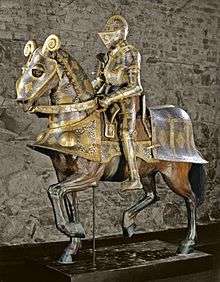
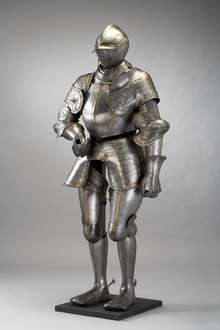
Plate armour is a historical type of personal body armour made from iron or steel plates, culminating in the iconic suit of armour entirely encasing the wearer. While there are early predecessors such as the Roman-era lorica segmentata, full plate armour developed in Europe during the Late Middle Ages, especially in the context of the Hundred Years' War, from the coat of plates worn over mail suits during the 13th century.
In Europe, plate armour reached its peak in the late 15th and early 16th centuries. The full suit of armour is thus a feature of the very end of the Middle Ages and of the Renaissance period. Its popular association with the "medieval knight" is due to the specialised jousting armour which developed in the 16th century.
Full suits of Gothic plate armour were worn on the battlefields of the Burgundian and Italian Wars. The most heavily armoured troops of the period were heavy cavalry such as the gendarmes and early cuirassiers, but the infantry troops of the Swiss mercenaries and the landsknechts also took to wearing lighter suits of "three quarters" munition armour, leaving the lower legs unprotected.[1]
The use of plate armour declined in the 17th century, but it remained common both among the nobility and for the cuirassiers throughout the European wars of religion. After 1650, plate armour was mostly reduced to the simple breastplate (cuirass) worn by cuirassiers. This was due to the development of the flintlock musket, which could penetrate armour at a considerable distance. For infantry, the breastplate gained renewed importance with the development of shrapnel in the late Napoleonic wars. The use of steel plates sewn into flak jackets dates to World War II, replaced by more modern materials such as fibre-reinforced plastic since the 1950s.
Early history
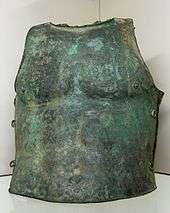
Partial plate armour, which protected the chest and the lower limbs, was used by the ancient Greeks (muscle cuirass) and Romans (lorica segmentata), but it fell into disuse after the collapse of the Roman Empire because of the cost and work involved in producing a piece of metal plate or cuirass. Parthian and Sassanian heavy cavalry units known as Clibanarii used cuirasses and small, overlapping plates in the manner of the manica for the protection of arms and legs.
Single plates of metal armour were again used from the late 13th century on, to protect joints and shins, and these were worn over a mail hauberk. Gradually the number of plate components of medieval armour increased, protecting further areas of the body, and in barding those of a cavalryman's horse. Armourers developed skills in articulating the lames or individual plates for parts of the body that needed to be flexible, and in fitting armour to the individual wearer like a tailor. The cost of a full suit of high quality fitted armour, as opposed to the cheaper munition armour (equivalent of ready-to-wear) was enormous, and inevitably restricted to the wealthy who were seriously committed to either soldiering or jousting. The rest of an army wore inconsistent mixtures of pieces, with maille still playing an important part.
Late Middle Ages
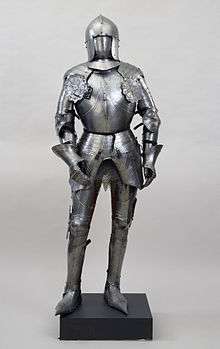
By about 1420, complete suits of plate armour had been developed. A full suit of plate armour would have consisted of a helmet, a gorget (or bevor), pauldrons with gardbraces in Italian and French armour to cover the armpits, or besagews (also known as rondels) which were mostly used in Gothic Armour, couters, vambraces, gauntlets, a cuirass (back and breastplate) with a fauld, tassets and a culet, a mail skirt, cuisses, poleyns, greaves, and sabatons. The very fullest sets, known as garnitures, more often made for jousting than war, included pieces of exchange, alternate pieces suiting different purposes, so that the suit could be configured for a range of different uses, for example fighting on foot or on horse.
A complete suit of plate armour made from well-tempered steel would weigh around 15–25 kg.[2] The wearer remained highly agile and could jump, run and otherwise move freely as the weight of the armour was spread evenly throughout the body. The armour was articulated and covered a man's entire body completely from neck to toe. In the 15th and 16th centuries plate armored soldiers were the nucleus of every army. Large bodies of men-at-arms numbering thousands or even more than ten thousand men (approximately 60% to 70% of French armies were men at arms and the percentage was also big in other countries) were fighting on foot wearing full plate next to archers and crossbowmen . This was commonly seen in the Western European armies especially of France and England during the Hundred Years War, the Wars of the Roses or the Italian Wars.
European leaders in armouring techniques were northern Italians, especially from Milan, and southern Germans, who had somewhat different styles. But styles were diffused around Europe, often by the movement of armourers; the Renaissance Greenwich armour was made by a royal workshop near London that had imported Italian, Flemish and (mostly) German craftsmen, though it soon developed its own unique style. Ottoman Turkey also made wide use of plate armour but incorporated large amounts of mail into their armour, which was widely used by shock troops such as the Janissary Corps.
Effect on weapon development

Plate armour was virtually invulnerable to sword slashes. It also protected the wearer well against spear or pike thrusts and provided decent defense against blunt trauma.
The evolution of plate armour also triggered developments in the design of offensive weapons. While this armour was effective against cuts or blows, their weak points could be exploited by long tapered swords or other weapons designed for the purpose, such as pollaxes and halberds. The effect of arrows and bolts is still a point of contention with regard to plate armour. The evolution of the 14th-century plate armour also triggered the development of various polearms. They were designed to deliver a strong impact and concentrate energy on a small area and cause damage through the plate. Maces, war hammers and the hammer-heads of pollaxes (poleaxes) were used to inflict blunt trauma through armour. Strong blows to the head might result in concussion even if the armor is not penetrated.
Fluted plate was not only decorative, but also reinforced the plate against bending under slashing or blunt impact. This offsets against the tendency for flutes to catch piercing blows. In armoured techniques taught in the German school of swordsmanship, the attacker concentrates on these "weak spots", resulting in a fighting style very different from unarmoured sword-fighting. Because of this weakness most warriors wore a mail shirt (haubergeon or hauberk) beneath their plate armour (or coat-of-plates). Later, full mail shirts were replaced with mail patches, called gussets, sewn onto a gambeson or arming jacket. Further protection for plate armour was the use of small round plates called besagews that covered the armpit area and couters and poleyns with "wings" to protect the inside of the joint.
Renaissance
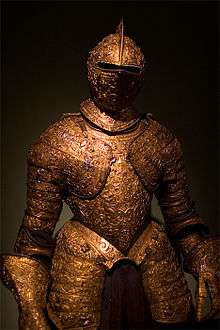

German so-called Maximilian armour of the early 16th century is a style using heavy fluting and some decorative etching, as opposed to the plainer finish on 15th-century white armour. The shapes include influence from Italian styles. This era also saw the use of closed helms, as opposed to the 15th-century-style sallets and barbutes. During the early 16th century the helmet and neckguard design was reformed to produce the so-called Nürnberg armour, many of them masterpieces of workmanship and design.[3]
As firearms became better and more common on the battlefield the utility of full armour gradually declined, and full suits became restricted to those made for jousting which continued to develop. The decoration of fine armour greatly increased in the period, using a whole range of techniques, and further greatly increasing the cost. Elaborately decorated plate armour for royalty and the very wealthy was being produced. Highly decorated armour is often called parade armour, a somewhat misleading term as such armour might well be worn on active military service. Steel plate armour for Henry II of France made in 1555 is covered with meticulous embossing, which has been subjected to blueing, silvering and gilding.[4]
Such work required armourers to either collaborate with artists or have artistic skill of their own; another alternative was to take designs from ornament prints and other prints, as was often done. Daniel Hopfer was an etcher of armour by training, who developed etching as a form of printmaking. Other artists such as Hans Holbein the Younger produced designs for armour. The Milanese armourer Filippo Negroli, from a leading dynasty of armourers, was the most famous modeller of figurative relief decoration on armour.
A partial exception to the declining protection offered by armour came in the Age of Discovery as Europeans encountered the natives of parts of the world still without firearms. The Spanish Conquistadors found armour extremely practical and (for both horses and men) intimidating to the Amerindians, and in the early North American Colonial period some pieces of armour, especially breastplates and helmets, continued to be worn.
Infantry
Reduced plate armour, typically consisting of a breastplate, a burgonet, morion or cabasset and gauntlets, however, also became popular among 16th-century mercenaries and there are many references to so-called munition armour being ordered for infantrymen at a fraction of the cost of full plate armour. This mass-produced armour was often heavier and made of lower quality metal than fine armour for commanders.[5]
Jousting

Specialised jousting armour produced in the late 15th to 16th century was heavier, and could weigh as much as 50 kg, as it was not intended for free combat, it did not need to permit free movement, the only limiting factor being the maximum weight that could be carried by a warhorse of the period.
The medieval joust has its origins in the military tactics of heavy cavalry during the High Middle Ages. These became obsolete during the 14th century, and since the 15th century, jousting had become a sport (hastilude) without direct relevance to warfare. During the 1490s, emperor Maximilian I invested a lot of effort into perfecting the sport, for which he received his nickname of "The Last Knight". Rennen and Stechen were two sportive forms of the joust developed during the 15th century and practiced throughout the 16th century. The armours used for these two respective styles of the joust was known as Rennzeug and Stechzeug, respectively. The Stechzeug in particular developed into extremely heavy armour which completely inhibited the movement of the rider, in its latest forms resembling an armour-shaped cabin integrated into the horse armour more than a functional suit of armour. Such forms of sportive equipment during the final phase of the joust in 16th-century Germany gave rise to modern misconceptions about the heaviness or clumsiness of "medieval armour", as notably popularised by Mark Twain's A Connecticut Yankee in King Arthur's Court.[6][7] The extremely heavy helmets of the Stechzeug are explained by the fact that the aim was to detach the crest of the opponent's helmet, resulting in frequent full impact of the lance to the helmet.
By contrast the Rennen was a type of joust with lighter contact. Here, the aim was to hit the opponent's shield. The specialised Rennzeug was developed on the request of Maximilian, who desired a return to a more agile form of joust compared to the heavily armoured "full contact" Stechen. In the Rennzeug, the shield was attached to the armour with a mechanism of springs and would detach itself upon contact.
 Stechzeug; note that the parts protecting the lower body and the legs were incorporated as part of the horse armour (not shown).
Stechzeug; note that the parts protecting the lower body and the legs were incorporated as part of the horse armour (not shown). Rennzeug
Rennzeug Armour designed for the Kolbenturnier, dated to the 1480s. The Kolbenturnier was a late form of the tournament, unlike the joust played with two teams using wooden clubs (Kolben) to hit opponents' helmet crests.
Armour designed for the Kolbenturnier, dated to the 1480s. The Kolbenturnier was a late form of the tournament, unlike the joust played with two teams using wooden clubs (Kolben) to hit opponents' helmet crests.
Early Modern period
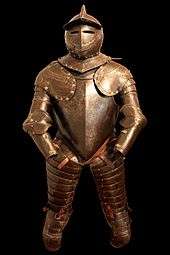
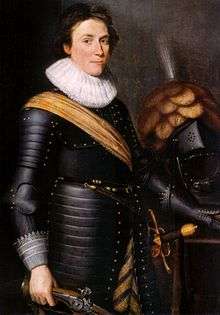
Plate armour was widely used by most armies until the end of the 17th century for both foot and mounted troops such as the cuirassiers, dragoons, demi-lancers and Polish hussars. The infantry armour of the 16th century developed into the Savoyard type of three-quarters armour by 1600.
Full plate armour was expensive to produce and remained therefore restricted to the upper strata of society; lavishly decorated suits of armour remained the fashion with 18th-century nobles and generals long after they had ceased to be militarily useful on the battlefield due to the advent of inexpensive muskets.
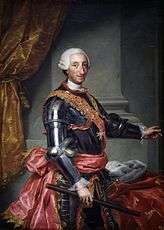
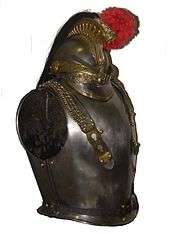
The development of powerful rifled firearms made all but the finest and heaviest armour obsolete. The increasing power and availability of firearms and the nature of large, state-supported infantry led to more portions of plate armour being cast off in favour of cheaper, more mobile troops. Leg protection was the first part to go, replaced by tall leather boots. By the beginning of the 18th century, only field marshals, commanders and royalty remained in full armour on the battlefield, more as a sign of rank than for practical considerations. It remained fashionable for monarchs to be portrayed in armour during the first half of the 18th century (late Baroque period), but even this tradition became obsolete. Thus, a portrait of Frederick the Great in 1739 still shows him in armour, while a later painting showing him as a commander in the Seven Years' War (1760s) depicts him without armour.
Body armour remained in use with cuirassiers throughout the 19th century and into the early phase of World War I. The cuirass represents the final stage of the tradition of plate armour descended from the late medieval period. Meanwhile, makeshift steel armour against shrapnel and early forms of ballistic vests began to be developed from the mid 19th century.
Japan

In Kofun period Japan, during the 4th and 5th centuries, very advanced iron plate cuirasses called tanko and helmets were made.[8] Plate armour was used in Japan during the Nara period (646-793), both plate and lamellar armours have been found in burial mounds and haniwa (ancient clay figures) have been found depicting warriors wearing full armour.[8]
In Japan the warfare of the Sengoku period (15th and 16th centuries) required large quantities of armour to be produced for the ever-growing armies of foot soldiers (ashigaru). Simple munition-quality[9] chest armours (dō) and helmets (kabuto) were mass-produced.
In 1543, the Portuguese brought matchlock firearms (tanegashima) to Japan.[10] The Japanese started to manufacture the Portuguese acquired matchlocks and the use of these firearms in warfare caused the gradual decline in the use of the centuries-old lamellar armour that the samurai were known for; the Japanese armour makers started to use solid iron plates in their armour designs which were based on European armours,[11] and eventually plate armour became the standard for samurai warriors.[12][13] The new style Japanese plate armours were called tosei gusoku (new armours) in order to differentiate from the old style lamellar armours.[14] Japanese armour makers designed bulletproof plate armours called tameshi gusoku or (bullet tested), which allowed soldiers to continue wearing armour despite the heavy use of firearms in the late 1500s.[15][16]
In the 1600s warfare in Japan came to an end but the samurai continued to use plate armour until the end of the samurai era in the 1860s, with the known last use of samurai armour occurring in 1877 during the Satsuma rebellion.[17]
Modern body armour


The cavalry armour of Napoleon, and the French, German, and British empires (heavy cavalry known as cuirassiers) were actively used through the 19th century right up to the first year of World War I, when French cuirassiers went to meet the enemy in armour outside of Paris.
Body armour made a brief reappearance in the American Civil War with mixed success. During World War I, both sides experimented with shrapnel armour and some soldiers used their own dedicated ballistic armour such as the American Brewster Body Shield, although none were widely produced. In 1916 General Adrian of the French army provided an abdominal shield which was light in weight (approx. one kilogram) and easy to wear.[18] A number of British officers recognised that many casualties could be avoided if effective armour were available. .[19]
The first usage of the term "flak jacket" refers to the armour originally developed by the Wilkinson Sword company during World War II to help protect Royal Air Force (RAF) air personnel from the flying debris and shrapnel.The Red Army also made use of ballistic steel body armour, typically chestplates, for combat engineers and assault infantry.[20]
After World War II, steel plates were soon replaced by vests made from synthetic fibre, in the 1950s, made of either boron carbide, silicon carbide, or aluminium oxide. They were issued to the crew of low-flying aircraft, such as the UH-1 and UC-123, during the Vietnam War.[21][22] The synthetic fibre Kevlar was introduced in 1971, and most ballistic vests since the 1970s are based on kevlar, optionally with the addition of trauma plates to reduce the risk of blunt trauma injury. Such plates may be made of ceramic, metal (steel or titanium) or synthetic materials.
See also
References
- ↑ Example of an armour worn by pikemen Germany circa 1600, on view at Lennart Viebahn Arms & Armour
- ↑ James, Lawrence (2003). Warrior Race: A History of the British at War. St. Martin's Press. p. 119. ISBN 0-312-30737-3.
- ↑ "Middle Ages: Armor". Middle Ages: Armor. MiddleAges.Net. Retrieved 5/8/2011. Check date values in:
|access-date=(help) - ↑ "Heilbrunn Timeline of History: The Decoration of European Armor". Metropolitan Museum of Art. Retrieved November 26, 2011.
- ↑ Wise, Terence (1983). The Wars of the Roses. Osprey Publishing. ISBN 0-85045-520-0.
- ↑ Ellis, John (1978). Cavalry: The History of Mounted Warfare. Putnam.
- ↑ Woosnam-Savage, Robert C.; Anthony Hall (2002). Brassey's Book of Body Armor. Potomac Books, Incorporated. ISBN 1-57488-465-4.
- 1 2 Oriental Armour, H. Russell Robinson, Courier Dover Publications, 2002, page 167.
- ↑ The Watanabe Art Museum Samurai Armour Collection, Volume I, Kabuto & Mengu, Trevor Absolon, page 130.
- ↑ Tanegashima: the arrival of Europe in Japan, Olof G. Lidin, Nordic Institute of Asian Studies, NIAS Press, 2002.
- ↑ The Grove encyclopedia of decorative arts, Volume 1, Gordon Campbell, Oxford University Press US, 2006, page 36.
- ↑ The Hutchinson dictionary of ancient & medieval warfare, Matthew Bennett, Taylor & Francis, 1998, page 145.
- ↑ Samurai: The Weapons and Spirit of the Japanese Warrior, Clive Sinclaire, Globe Pequot, 2004, page 49.
- ↑ Samurai: The Weapons and Spirit of the Japanese Warrior, Clive Sinclaire, Globe Pequot, 2004, page 32.
- ↑ The Watanabe Art Museum Samurai Armour Collection, Volume I, Kabuto & Mengu, Trevor Absolon, Trevor Absolon, page 16
- ↑ The Watanabe Art Museum Samurai Armour Collection, Volume I, Kabuto & Mengu, Trevor Absolon, page 78.
- ↑ Samurai: The Weapons and Spirit of the Japanese Warrior, Clive Sinclaire, Globe Pequot, 2004, page 58.
- ↑ Helmets and body armor in modern warfare (Google eBook), Bashford Dean, Metropolitan Museum of Art (New York, N.Y.), Yale University Press, 1920, Pages 107-111
- ↑ Beyer, J.C., ed. Personnel Protective Armor, Chapter 11 in Wound Ballistics, Coates, J.B., ed., Office of the Surgeon General, Department of the Army, Washington, D.C., 1962
- ↑ Body Armor History - A history of soft body armor from medieval times to modern times
- ↑ Barron, Edward R.; Park, Alice F; Alesi, Anthony L (January 1969). "Body Armor for Aircrewman" (PDF). U.S. Army Natick Laboratories. Retrieved 2008-11-12.
- ↑ "Who are you calling Chicken?". VietnamGear.com. 2006-07-03. Retrieved 2008-11-12.
Further reading
| Wikimedia Commons has media related to Plate armour. |
- R. E. Oakeshott, European weapons and armour: From the Renaissance to the industrial revolution (1980).
- Brian R. Price, Techniques of Medieval Armour Reproduction. Boulder, CO: Paladin Press, 2000.
- Ortiz, A.; Carretero, C.; et al. (1991). Resplendence of the Spanish monarchy : Renaissance tapestries and armor from the Patrimonio Nacional. New York: The Metropolitan Museum of Art. (see index)